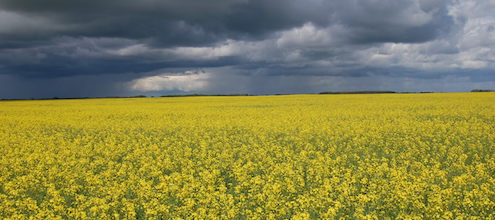
A legal bout in the U.S. shines light on some of the big challenges with biofuels in Canada
Biofuel policy south of the border is heating up. On January 8th seven agricultural and biofuel groups initiated a court challenge against a recent ruling by the Environmental Protection Agency (EPA), which lowers the mandated minimum renewable fuel content in gasoline and diesel. The court challenge is interesting in its own right, but the rationale for the EPA’s ruling—and the industry’s response—highlight bigger issues: namely, that large-scale production of biofuels is constrained by a range of economic, technological, and environmental challenges. Although the context in Canada is different, the ongoing debate over biofuels in the U.S. lends key insights into our own biofuels policy.
The U.S. is mandating less use of biofuels
Biofuel mandates in the U.S.—i.e., policies that require a certain level biofuel blending into gasoline—are evolving. In 2005 the U.S. government implemented the Renewable Fuel Standard (RFS), requiring producers to blend minimum amounts of ethanol and biodiesel in gasoline and diesel. The RFS prescribes specific and increasing volumes of renewable fuels over the 2007–2022 period, and requires fuel producers to use renewable fuels that lower greenhouse gas emission compared to the petroleum fuels they displace.
In 2007, the EPA originally projected that a minimum of 22.3 billion gallons would be blended with petroleum by 2016. The revised blend mandates, however, require only 18.1 billion gallons—a drop of nearly one-fifth in the anticipated volume. Agricultural and biofuel groups disagree with the revised numbers as it will likely mean lower demand for biofuels, and in particular corn ethanol; their court challenge against the EPA is an effort to have mandates restored to original levels.
A lower mandate follows lower expectations for biofuels
Let’s take a step back. Why is the EPA making changes to these mandates? There are two main reasons.
First, pushing the fuel mandates beyond the revised levels risks breaching the ‘blend wall’. This refers to the internal damage caused to cars by using concentrations of ethanol beyond about 10% in gasoline (E10). Unless cars are specifically made to withstand higher concentrations of ethanol, exceeding the blend wall can cause substantial corroding to the gas tank, pumps, fuel lines, and injectors. Part of the problem is from the unexpected drop in demand for petroleum fuels in the U.S., which lowered the overall fuel base from which the RFS is calculated. To avoid surpassing this 10% threshold, potentially exposing drivers to costly repairs and industry and government to liability issues, the EPA was pressured to lower the mandates to reflect the weaker fuel demand.
The second reason for the lower fuel mandate is because of the slow progress in developing alternatives to biofuels made from agricultural feedstocks. Fuel mandates have almost exclusively been filled with corn-based ethanol, which raise a host of concerns about their impacts on greenhouse gas emissions, air and water pollution, and increasing food prices. In particular, a growing number of studies (here, here, and here) demonstrate that when all lifecycle emissions are accounted for—including indirect land-use emissions—emission reductions can be small or even negative.
Advanced and cellulosic fuels, derived from wood waste, algae, or solid waste, were expected to replace corn-based biofuels and, eventually, launch biofuels into a more sustainable era. But hope for advanced biofuels remains thin: in 2009 the EPA cut the fuel mandate for cellulosic ethanol from 100 million gallon to only 6.5 million gallons.
The EPA’s ruling highlights some of the big challenges with biofuel policy
Direct impacts from the EPA’s ruling in Canada will probably be minimal. Although Canadian biofuel producers trade with their U.S. counterparts, the ruling is unlikely to disrupt cross-border supply chains. In fact a lower-than-expected fuel mandate in the U.S. may generate an excess supply of corn-based ethanol, meaning lower prices for Canadian importers.
What’s more important from the ongoing tussle between the biofuels industry and Uncle Sam, however, are the bigger issues behind the scenes, especially around crop-based biofuels. Like the U.S., nearly all ethanol, and one-half of biodiesel produced, are produced from agricultural crops in Canada. And aside from a few small-scale demonstration facilities, advanced biofuels are still in their infancy. As such, Canada relies on crop-based fuels to fulfill federal and provincial fuel mandates (which are lower than those in the U.S.), and therefore face similar environmental and economic trade-offs with supporting biofuels in their current form.
If nothing else, Canadian policy-makers should view the ongoing debate in the U.S. as an issue that could eventually arrive at our doorstep. Many of the provincial and federal subsidies for biofuels end this year and next, opening the door for policy reform. Further, governments across Canada face pressure from industry to raise the existing fuel mandates (here and here) to levels closer to those in the U.S.
Smart biofuels policy may hold potential to make transportation more sustainable. But by the same token, policy done poorly can be fiscally wasteful, increase environmental damage, and distort agricultural markets. Getting it right therefore requires carefully assessing the environmental, technological, and economic case for biofuels, especially those derived from agricultural crops. Moving forward, let’s hope that some of the lessons from the U.S. courthouse are heeded north of the 49th.




Comments are closed.